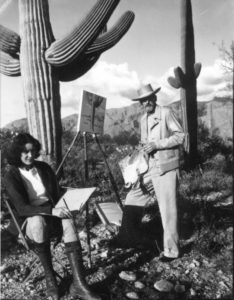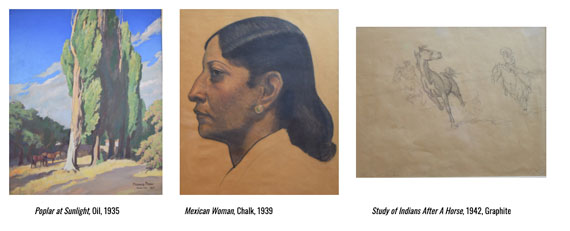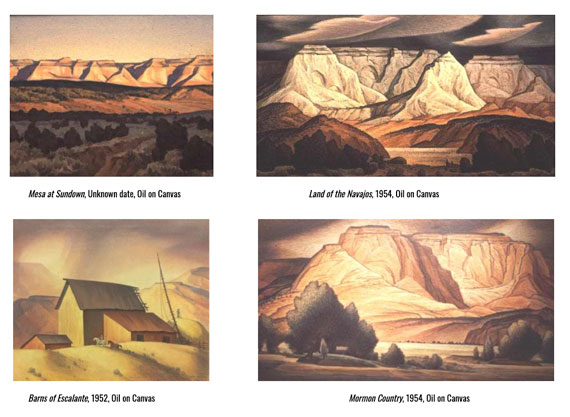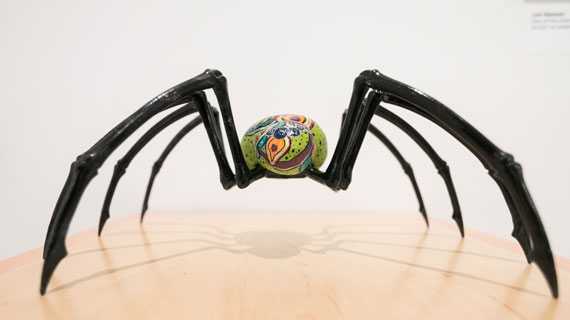SUMA Artist Feature: Solitude Makes the Heart Grow Fonder
Posted: February 16, 2021 | Author: Hannah Zander | Read Time: 3 minutes
 The 1930’s were a time of great uncertainty, but also tremendous growth. America was stricken by the Great Depression, but the Works Progress Administration’s Federal Art Project had provided opportunity and a level of stability to artist’s of the time. What came of the project included a bloom in public art production, and highlighted a wave of iconic careers including the young social realist painter Edith Hamlin, and the well-established western landscape painter Maynard Dixon.
The 1930’s were a time of great uncertainty, but also tremendous growth. America was stricken by the Great Depression, but the Works Progress Administration’s Federal Art Project had provided opportunity and a level of stability to artist’s of the time. What came of the project included a bloom in public art production, and highlighted a wave of iconic careers including the young social realist painter Edith Hamlin, and the well-established western landscape painter Maynard Dixon.
It was because of this project, Edith and Maynard first met in San Francisco. Both had a studio down the hall from one another in the North Beach district near the Coit Tower, where Edith had been working on a collaborative mural in 1933. Maynard had recently begun his “forgotten man” series, in which he pivoted from the romance of the “true west” to the financially downtrodden he observed in the city’s environment. They worked together on Edith’s second WPA Federal Art Project mural for the Mission High School in San Francisco. Maynard assisted Edith in painting the facial features of her subjects.
 This time together formed a strong bond between them, and when both of their previous spouses had found others, a full romance between Edith and Maynard was able to develop. They married in Carson City, Nevada in 1937. Shortly after tying the knot, the couple established a home in Tucson, Arizona and spent their summers in Mt. Carmel, Utah, just east of Zion National Park.
This time together formed a strong bond between them, and when both of their previous spouses had found others, a full romance between Edith and Maynard was able to develop. They married in Carson City, Nevada in 1937. Shortly after tying the knot, the couple established a home in Tucson, Arizona and spent their summers in Mt. Carmel, Utah, just east of Zion National Park.
“It had been Maynard’s dream for a long time to live in such southwestern areas. The desert had always attracted him. It was a kind of mystique, in a way. The desert to him was a release of a kind, a freedom that he didn’t know in cities. To leave his troubles behind and to really immerse himself completely in his painting in the great outdoors, was a kind of renewing grace—a salvation.” - Edith Hamlin
Edith has referred to their time when summering in southern Utah as their “golden years,” despite Maynard’s progressively deteriorating health from late stage emphysema. Knowing that their time together was approaching an end, it became precious, their shared love for the desert and each other, more sacred. When Maynard passed on, Edith announced his death accompanied with one of his poems, then dispersed his ashes on their Mt. Carmel property where he would often sit to take in the splendor.
AT LAST
At last,
I shall give myself to the desert again,
that I, in its golden dust,
may be blown from a barren peak
broadcast over the sun-lands.
If you should desire some news of me, go ask the little horned toad whose home is the dust,
or seek it among the fragrant sage,
or question the mountain juniper,
and, by their silence,
they will truly inform you.
- Maynard Dixon
Pieces in SUMA’s Permanent Collection
Maynard Dixon

Edith Hamlin

Produced by the Southern Utah Museum of Art
Located on the campus of Southern Utah University, SUMA features the artwork of regional artists known for their landscapes, faculty and student artists from the SUU Department of Art & Design, as well as emerging and distinguished artists from around the country. Strengths of the nearly 2,000-object permanent collection include the body of work by Jimmie F. Jones that exemplifies his notable career in the region, as well as a robust collection of prints featuring well-known artists such as Pierre-Auguste Renoir, Salvador Dalí, Katsushika Hokusai, Thomas Hart Benton, and others. Part of the Beverley Taylor Sorenson Center for the Arts, which also includes the Utah Shakespeare Festival, SUMA is free and open to the public.
This article was published more than 3 years ago and might contain outdated information or broken links. As a result, its accuracy cannot be guaranteed.
Tags: SUMA


